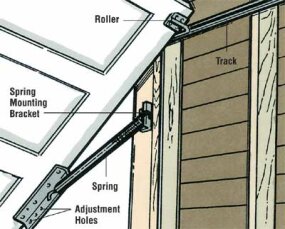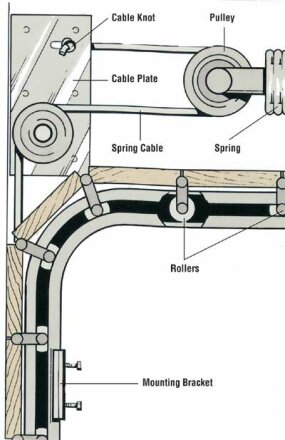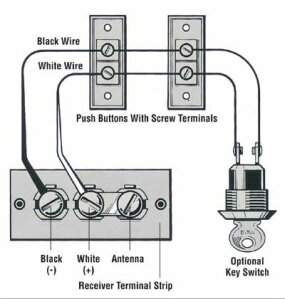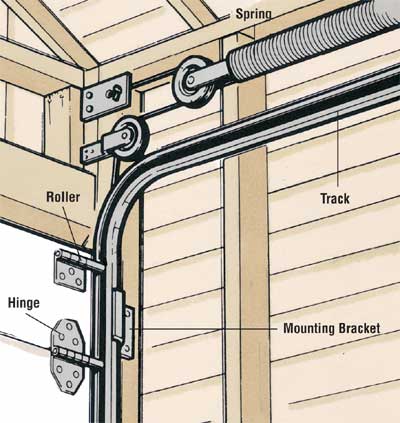There are two main components to a garage door: the door itself and the opener. In this article, we'll tell you how to make repairs to both things. We'll start with the actual door.
Repairing a Garage Door
Overhead garage doors, whether they roll up in sections or swing up in one piece, operate on spring tension. The door moves on metal tracks on the garage walls, and a heavy spring or springs provide the power. In most cases when the door doesn't work easily, repairs are fairly simple. Here are some helpful repair tips:
Step 1: Check the metal tracks inside the garage. Look at the mounting brackets that hold the tracks to the walls. If they're loose, tighten the bolts or screws at the brackets. Working inside the garage with the garage door closed, examine the tracks for dents, crimps, or flat spots. If there are any damaged spots, pound them out with a rubber mallet, or with a hammer and a block of scrap wood. If the tracks are badly damaged, they should be replaced.
Step 2: Check the tracks with a level to make sure they're properly aligned. Horizontal tracks should slant slightly down toward the back of the garage; with roll-up doors, the vertical sections of track should be exactly plumb. Both tracks must be at the same height on the garage walls. If the tracks are not properly aligned, loosen but do not remove the screws or bolts that hold the mounting brackets, and tap the tracks carefully into position. Recheck the tracks with the level to make sure they're in the right position; then tighten the screws or bolts at the mounting brackets.
Step 3: Clean the tracks with concentrated household cleaner to remove dirt and hardened grease. Clean the rollers thoroughly, and wipe both tracks and rollers dry.
Step 5: Check for loose hardware, and tighten as needed. On swing-up doors, check the plates where the spring is mounted to be sure the screws are tight, and tighten any loose screws. On roll-up doors, check the hinges that hold the sections of the door together; tighten any loose screws, and replace any damaged hinges. Sagging at one side of the door can often be corrected by servicing the hinges. If a screw hole is enlarged, replace the screw with a longer one of the same diameter, and use a hollow fiber plug, dipped in carpenters' glue, with the new screw. If the wood is cracked at a hinge, remove the hinge and fill the cracks and the screw holes with wood filler. Let the filler dry and then replace the hinge. If possible, move the hinge onto solid wood.

Caution: If a roll-up door has only one torsion spring, at the center of the door, do not try to repair it. The tension is so great that the spring could injure you. For doors with this type of spring, call a professional repair service.

Sometimes the problem with your garage door can be traced to the opener. In the following section, we'll show you how to replace a garage door opener.
A garage door opener is one of the handiest gadgets you can install in your home. And you can install it yourself following these general instructions and the specific instructions that come with the unit.
The typical garage door opener consists of a reversible motor that drives a carriage along a rail above the door. Attached to the carriage is a drawbar to move the door between its opened and closed positions, with travel-limiting devices to stop the door's movement precisely at the fully opened and fully closed positions. A relay or reversing switch reverses the direction of drive from opening to closing and back again. Most modern garage door openers include a radio receiver that allows you to open the door by sending a signal from an electronic module in your car.
Here's how to install a garage door opener:
Step 1: The mechanism should be installed at the center of the door. To determine the location, use a tape measure to figure the width of the garage door. Half this distance is the center. On the inside of the door, toward the top, draw a short vertical line down the center of the door. When you affix the drawbar (the mechanism for raising and lowering the door) at this line, the door weight will be evenly balanced at the lifting point.
Step 2: Raise and lower the door, observing the top point of its travel. Mark this location, because you must mount the opener so that the rail is higher than the peak of the door's travel. Otherwise, as the door opens, it could strike the rail.
Step 3: Inspect the area right above the garage door at your vertical dividing line; there must be a support in that location suitable for attaching the front end of the rail. If your garage lacks a structural member in that location, install a front mounting board. Center and fasten a length of 2 X 6-inch plank securely with lag screws across two wall studs over your mark of highest door travel. Transfer your high-point mark to this plank, and extend the vertical door center line onto the plank as well.
Step 4: Attach the rail to the motor unit on the garage floor, following the procedure outlined in the kit instructions. With the garage door down, lift and fasten the outermost end of the rail to the front mounting plank at a location about two inches above the intersecting marks you made for your door's high point and center line. The rail bracket provided for this purpose usually fastens to the front mounting plank with lag screws. If bolts and nuts are provided, however, you must drill suitable holes through the front mounting plank. Be sure to use washers under the heads of the bolts to keep them from pressing into the wood.
Step 5: Raise the motor assembly to the point where the rail is horizontal, or parallel with the door track. With the motor assembly held or supported in this position, raise and lower the garage door by hand to be sure that the rail location does not interfere with the door's movement. Once you establish the correct position and height for the motor assembly, fasten it to the garage joists with the metal brackets in the kit. If the position of the motor assembly is between two joists, or if the garage joists run the same direction as the rail, you'll need to fasten a length of 2 X 4 across the joists, and then mount the brackets to the 2 X 4. If your garage ceiling is finished, you can mount a 3/4-inch plywood panel overhead, fastening it to the joists with lag screws. Attach the mounting hardware to the plywood panel with heavy-duty toggle bolts.
Step 6: Attach the drawbar to the rail carriage, and move the carriage to its closed-door position. Mark the drawbar mounting-screw holes on the garage door, and drill the holes in the door. With the drawbar mounted and the holes drilled, insert and tighten the attaching hardware that fastens the drawbar to the door.
Step 7: Make all the necessary adjustments to the drive chain or lead screw, observing particularly the location of the bolts that limit the chain's travel.
Step 8: Install the radio receiver and manual push button. You can use ordinary bell wire for the push button, but be sure to place it where you can see the garage door opener in operation when you push the button. You can also install an optional key switch.
Step 9: Plug the drive assembly cord into an extension cord, and plug the extension cord into a convenient receptacle. Set the garage door in motion, using the manual push button. During the door's first test rising, pull the plug from the extension cord several times so you can check to be sure that there is no binding anywhere and that the lifting action is satisfactory. Make any necessary corrections using the adjustment provisions built into the garage door opener system, and verify the operation of the radio remote module.

Step 10: Disconnect the extension cord, and plug the drive assembly line cord into its permanent outlet. If possible, connect the cord to the garage overhead light socket.
Now you'll be able to make basics garage-door repairs, whether it's to the door itself or the opener.
©Publications International, Ltd.
Article Source: How to Repair a Garage Door
Related Article: 5 Garage Door Repair And Maintenance Tips
If you need profesional assistance for garage door repair, call Johns Creek Garage Masters at (678) 671-5032. You also click here to visit our main website.



